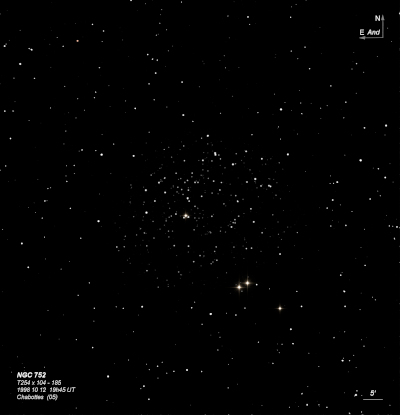
Caroline Herschel discovered NGC 752 = H VII-32 = h174 on 29 Sep 1783, though this cluster is a naked-eye object. According to Wolfgang Steinicke, William found it a month earlier on 24 Aug, while observing with his 6.2-inch reflector. On 21 Sep 1786 (sweep 599), he called it "a vL coarse scattered cluster of vL stars, irregularly round, very rich. I suppose it takes up half a degree." Later he noted "like a nebulous star to the naked eye." But Italian astronomer Giovanni Batista Hodierna may have found the cluster earlier around 1654.
200/250mm - 8" very large, bright, many doubles, overfills low power field. Easy naked-eye open cluster in dark sky.
400/500mm - 17.5" (11/1/97): easy naked-eye cluster, overfills the 100x field (20mm Nagler). The brightest star is a yellowish mag 7 star just south of center. Two equal mag companions to the south form an isosceles triangle. There are no dense regions and the many brighter mag 9-10.5 stars are pretty evenly distributed throughout the field. Many of the stars appear to be arrange in long strings and arcs, though. There are perhaps 150 stars in the field (difficult to count) with a few nice pair and trios. Off the SW side just out of the field is a wide bright pair of mag 5.7/5.9 stars at 3.6' (naked-eye). The western of these two stars (56 Andromedae) has a striking orange-red hue and a faint companion.
Notes by Steve Gottlieb